Peru: Concluding Statement of the 2017 Article IV Mission
May 26, 2017
I. Context and Recent Developments
1. After sustained improvements in macroeconomic and social indicators since the turn of the century, Peru is looking ahead to the challenge of becoming a high-income nation . With average growth of over 5¼ percent since 2000, Peru has significantly reduced unemployment and poverty. Inflation is in low single digits, the fiscal position has strengthened, and dollarization has declined markedly. In the context of the commodity boom, sound macroeconomic management and structural reforms have played an essential role in this improvement. Consolidating these gains and pursuing further reforms to modernize the economy and strengthen institutions will be critical in helping Peru reach high-income status. Given the experience of other countries, care will be needed to avoid being stuck in a “middle income trap”. Importantly, even if high-income status is attainable, international experience suggests that it will take time.
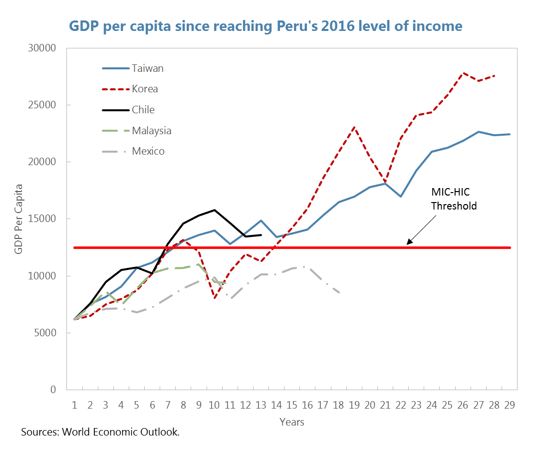
2. The government has introduced several structural reforms aimed at modernizing the economy, increasing formality, and lifting potential growth through greater investment and productivity gains . These reforms intend to tackle the main inefficiencies in the economy in investment procedures, tax collection, financing costs, and labor market and social protection. They include: (i) a new institutional framework for public and public-private infrastructure investment aimed at reducing red tape; (i) improving the business climate by cutting administrative procedures and promoting the digitalization of processes; and (iii) a new tax regime for small and medium enterprises to make the current tax system more progressive, reduce compliance costs, stimulate the use of electronic means of payment and formalize the value chain. The government is also looking to modernize labor regimes and has set up a Social Protection Commission tasked with delivering a comprehensive and fiscally sustainable reform of the social security system. The aim of the latter is to increase coverage while reducing informality.
3. The current juncture is a difficult one given domestic headwinds and challenging external conditions . The Odebrecht corruption scandal that broke in December 2016 is weighing on investment and confidence. And one of the worst flooding and landslides in over 50 years (related to el Niño) has affected a significant part of the population, caused widespread infrastructure damage, and raised domestic food prices. On the external side, although commodity prices have recovered somewhat since late 2016, they remain significantly lower than during the commodity boom. There also remains significant uncertainty about the U.S. outlook and how much protectionist pressures will rise globally.
4. The authorities have reacted rapidly to the changes in domestic and external conditions . Responding to the Odebrecht scandal and floods, the Ministry of Economy and Finance has put together a plan aimed at supporting growth, including: (i) a fiscal package of 1.3 percent of GDP targeted at reconstruction needs and public investment; (ii) a relaxation in the near-term fiscal consolidation path; (iii) an exemption from healthcare contributions (nine percent of monthly wages) when employers hire new young entrants to the labor market; (iv) initiatives to support affordable housing developments, and (v) easing SMEs’ access to financing. The SBS has also given banks the ability to restructure retail debt in disaster-affected areas for up to six months without affecting borrowers’ credit ratings. To support credit conditions in an environment characterized by a slowdown in credit growth and higher international interest rates, the BCRP has reduced reserve requirements four times since December 2016. In addition, the policy rate was cut by 25 basis points for the first time in 15 months in May 2017, given a weaker inflation outlook.
II. Outlook and Risks
5. While slowing given sizable domestic shocks, growth will remain high relative to the region in 2017 . With the current wave of copper projects reaching full capacity, the contribution of exports to economic growth is projected to decline from nearly 2½ percentage points in 2016 to just over ½ percentage point in 2017. At the same time, large infrastructure projects are being delayed in the wake of the Odebrecht scandal, and the flooding and landslides have destroyed a significant chunk of the capital stock. Nonetheless, a planned increase in government investment, combined with the announced stimulus plan and the emergency reconstruction funds, are expected to offset part of this decline, with the government contribution to growth increasing by nearly 1 percentage point. Overall, growth is expected to decline to about 2.7 percent in 2017. Inflation should gradually return to the target range as weather-related factors abate and food inflation declines.
6. After a bounceback in 2018–19, growth is projected to converge to its potential of 3¾ percent in the medium term, while the fiscal deficit narrows . The near-term growth bounceback is predicated on reconstruction spending and public investment projects, underpinned by the fiscal stimulus plan. There would also be a recovery in private sector investment in part reflecting a catch-up effect of projects delayed by the Odebrecht scandal and other factors. With the output gap closing by 2021, growth is projected to return to the potential growth rate, while the government accelerates its consolidation towards the (one percent deficit) target in the fiscal rule.
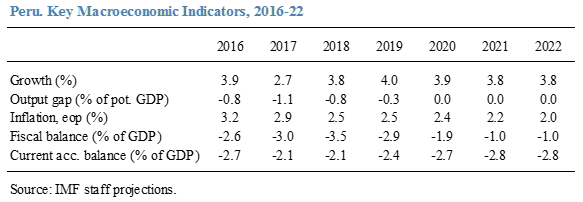
7. Risks are tilted to the downside in 2017 but there is some upside potential in the medium term . Downside risks stem from additional delays in executing investment projects, larger than expected flood-related damages, a faster rise in international interest rates, and global spillovers from a rise in protectionism or a slowdown in China. On the upside, structural reforms could proceed at a faster pace if the authorities’ reform program gains greater traction than assumed in the baseline (e.g., if the recommendations of the Social Protection Commission lead to meaningful labor market reform). Some new mining projects could come also onstream in the medium term, and higher infrastructure spending in systemically important countries could push up commodity prices. These upsides could have a sizable impact on productivity, increasing potential growth to 4-4.5 percent.
III. Policy Recommendations
8. In the context of domestic headwinds and challenging external conditions, a combination of countercyclical policies and structural reforms is appropriate . In the short term, agile fiscal and monetary policies will help the economy meet reconstruction needs, while preserving Peru’s strong fiscal and inflation anchors. Structural reforms constitute an essential complement to these short-term actions, as lifting potential growth hinges on efforts aimed at closing infrastructure gaps, diversifying the production base, reducing economic informality, deepening financial intermediation, and improving governance, including by fighting corruption and strengthening institutions.
A. Tackling Multiple Fiscal Objectives
9. A moderate and temporary fiscal loosening is justified at the current juncture . Due to prudent fiscal policy in the past and low net public debt, the government has ample fiscal space to address flood-related reconstruction needs. The fiscal stimulus plan is also appropriate given the existing output gap and the expected deterioration in domestic demand. However, the success of this plan depends on executing a high level of investment spending, which has historically proven to be difficult in Peru. In this regard, staff welcomes recent government efforts to raise execution rates, including by effecting annual transfers to subnational governments earlier in the year (by the end of the first quarter). Over the medium term, the credibility of the fiscal strategy will depend on converging back to the original deficit target of one percent.
10. The move away from a structural balance rule has advantages as well as challenges . Cross-country experience with structural deficit rules has been mixed. For sure, headline deficit targets are more transparent and easy to communicate. Moreover, the new rule maintains key checks and balances embedded in the previous rule to ensure that fiscal policy is conducted responsibly (e.g. the Fiscal Council), even as it is still informed by structural balance trends and contains appropriate escape clauses. The latter have been appropriately called upon currently to finance reconstruction needs. Headline deficit targets are challenging though, as they require a sustained effort to broaden the tax base and avoid recourse to procyclical spending measures. Avoiding increasing spending rigidities more generally is also recommended to help facilitate the medium-term fiscal consolidation.
11. Staff agrees on the infrastructure needs and recommends continued efforts to improve revenue collection . Regarding infrastructure gaps, the quality of infrastructure compares unfavorably with that of trade competitors and the government’s focus on this is welcome, including by reforming the system of public investment (creating Invierte.pe). Staff recommends also keeping a focus on enhancing capacity to implement projects at the sub-national level and raising the tax to GDP ratio. Reflecting lower commodity revenues, the latter has fallen to a low of around 14 percent of GDP and is below the regional average.
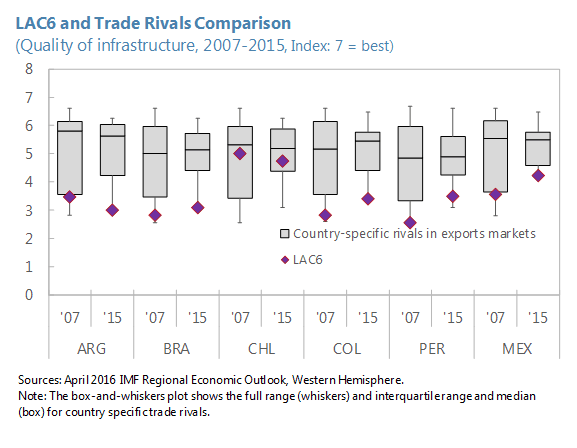
12. Staff welcomes the authorities’ plan to establish a medium-term budgeting framework (MTBF) and suggests complementing this by improving the PPP framework and introducing a comprehensive approach to monitoring fiscal risks . An MTBF should improve consistency between the annual budget and macro-fiscal aggregates, enhancing fiscal discipline, costing of policies, and predictability of the budget process. Good examples include, Australia, Canada, Sweden and the UK. Regarding PPPs, Peru’s framework is considered relatively good by international standards and efforts to enhance capacity at Proinversión are welcome. There is scope, however, to improve certain facets, for example the procurement phase given a high level of contract renegotiations and cost overruns. In line with previous IMF technical assistance, staff also recommends publishing an annual comprehensive fiscal risks statement, covering contingent liabilities and risks associated with investment plans. This is especially important given the objective of ramping up infrastructure spending.
B. Striking the Right Monetary Policy Balance
13. The next monetary policy steps need to be considered carefully and communication will be key . With the output gap widening, temporary weather-related price pressures expected to abate quickly, and core inflation remaining within the target range, staff supports the BCRP’s recent reduction of the policy rate. Looking ahead, fiscal policy has the advantage of facilitating both a demand and supply response (e.g. reconstruction of housing and infrastructure). Given the availability of fiscal space, this suggests fiscal policy should be the first line of defense if flood damage turns out to be higher than expected. Monetary policy can provide a useful complement if demand conditions deteriorate further, but the BCRP will need to continue to remain data dependent and monitor inflation expectations closely for any signs of a persistent drift above the target range. Regarding local currency reserve requirements, future changes should be clearly tied to the credit cycle. Clear communication regarding the temporary nature of existing price shocks and the inflation outlook will be essential to continue anchoring inflation expectations.
14. Increased exchange rate flexibility and the unwinding of the BCRP’s FX intervention instruments have been important steps . Peru’s external position is assessed to be broadly consistent with fundamentals and appropriate policy settings. Going forward, exchange rate flexibility remains important as demonstrated by the increased resilience of domestic demand in Latin America to recent current account adjustment under flexible exchange rate regimes. And the recent declines in credit dollarization help limit the adverse impact (via balance sheet effects) of exchange rate movements on domestic demand and financial sector soundness. Staff welcomes the smooth unwinding of the BCRP’s FX swaps and its beneficial impact in terms of fostering a market-determined exchange rate. Future FX interventions should be limited to cases of disorderly market conditions. This will also help further develop hedging markets.
C. Fostering Financial Stability and Development
15. Peru’s financial system remains sound, with stability risks mainly arising from adverse economic developments and substantial exchange rate depreciation . Corporate leverage has increased, although sensitivity analysis suggests that risks are low. Banks exhibit high profitability and capitalization ratios, and low ratios of nonperforming loans. The rest of the system is also sound, but with more variability across institutions and a growing financial cooperatives segment. While dollarization has declined, it remains a structural risk. Overall, BCRP and SBS solvency stress tests indicate that the largest risks stem from decelerating economic growth and a large and sudden depreciation of the currency, although buffers appear sufficiently strong to withstand a stress scenario. Systemic risk also appears contained, with the joint probability of distress of the seven largest banks declining since its peak in 2010 and remaining at a low level. [1]
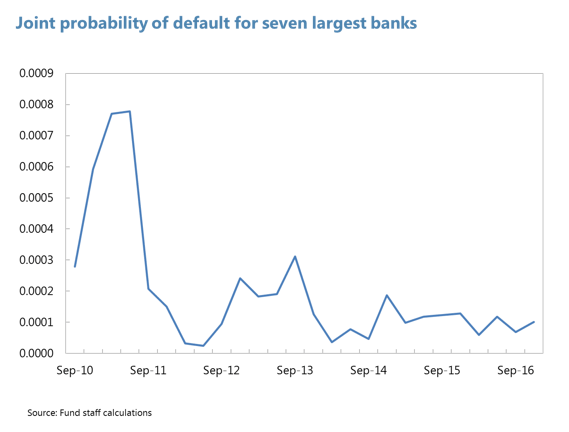
16. To guard against stability risks, the following steps are recommended:
a. Consolidating dedollarization gains . While measures already in train should still have a marginal impact (e.g. targets on banks’ share of dollar loans), another potential measure could be increasing FX provisions for FX loans to unhedged borrowers.
b. Establishing a financial stability council. This could formalize the regular meetings between the BCRP, MEF, and SBS, while maintaining the mandates and operational autonomy for the individual agencies. While there is no one-size-fits-all, and there are various models to achieve this (e.g. New Zealand, the U.K, and Germany), key features include a clear mandate that sets out well-defined objectives, strong accountability, and mechanisms to foster cooperation among agencies. A coordinated council would help to raise awareness about potential risks, facilitate consensus building, and identify overlaps and gaps in monitoring vulnerabilities.
c. Broadening the regulatory and supervisory perimeter. The rapid expansion of the financial cooperatives sector needs to be carefully monitored, as several cooperatives have grown to be as big as the small banks in the system. Bringing the larger cooperatives under direct SBS supervision would be desirable.
d. Developing a national house price index. The property sector has grown rapidly, though there has been some price moderation recently and indicators for Lima do not suggest overheating. Staff welcome the additional steps the BCRP is taking to create an index that includes other major cities. This would allow a more comprehensive assessment of risks.
17. Perhaps the biggest challenges (and rewards) are associated with financial deepening and inclusion . Tremendous progress has been made in branch penetration, which quadrupled over the last decade. But overall financial depth remains low, relative to fundamentals and the region. Financial inclusion is also low—the Global Findex (2014) shows that only about 30 percent of the Peruvian population aged over 15 has a bank account, below regional (51 percent) and income peers (58 percent). Notwithstanding recent reforms in the stock market, capital markets lack depth and liquidity. While there are no quick fixes, private initiatives to develop mobile payment platforms ( Billetera Móvil) are welcome. Further efforts to reduce informality and increase literacy and financial education will be important.
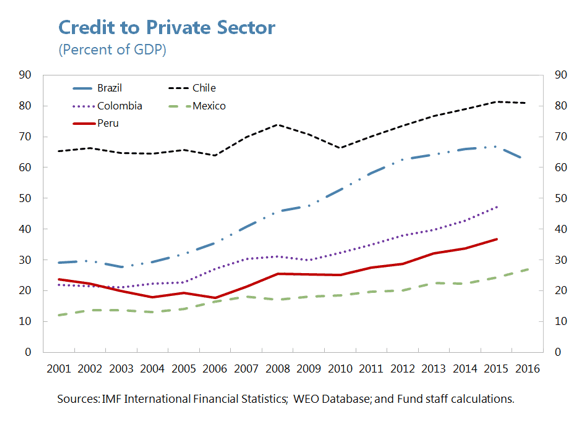
D. Increasing Potential Growth through Structural Reforms
18. A multi-pronged approach is needed to increase potential growth, especially in the context of lower commodity prices . The 2016–17 Global Competitiveness Report (GCR) suggests that Peru is more competitive relative to other Latin American countries, but lagging trade rivals and OECD countries in many areas. Key areas for improvement in the journey to high-income status include education, infrastructure, innovation, and institutions. And the government is focusing on many of these areas as well as pursuing reforms to reduce informality. A comprehensive package—including making labor regulations significantly more flexible and ensuring labor costs grow in line with productivity—will likely be necessary to decisively dent informality. The Social Protection Commission has an important mandate in this regard.
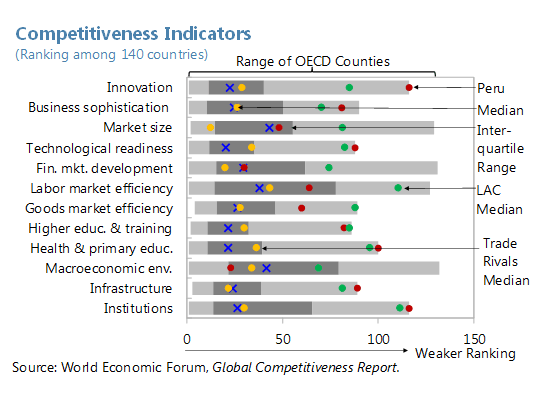
19. The Odebrecht case has underscored the problem of corruption. The government has undertaken steps to address this issue, including extending bans for corrupt public officials, designating a special investigative team focused solely on the Odebrecht case, and barring any company that has admitted/been convicted of corruption from new bids on government projects as well as ringfencing their assets in Peru. But additional anti-corruption measures will likely be needed, including strengthening the anti-corruption legal framework and institutions and adopting international best practices for the Office of the Comptroller General. Effective implementation of anti-money laundering measures in line with the international standards, for example enhanced due diligence for politically exposed persons, would also help to prevent the misuse of the financial system by corrupt officials.
We would like to take this opportunity to thank the Peruvian authorities and private sector representatives for their hospitality and open and constructive dialogue.
[1] Calculated as the probability that all seven banks are simultaneously in distress, where distress is defined as unexpected losses exceeding 7.5 percent of capital.
IMF Communications Department
MEDIA RELATIONS
PRESS OFFICER: Raphael Anspach
Phone: +1 202 623-7100Email: MEDIA@IMF.org


